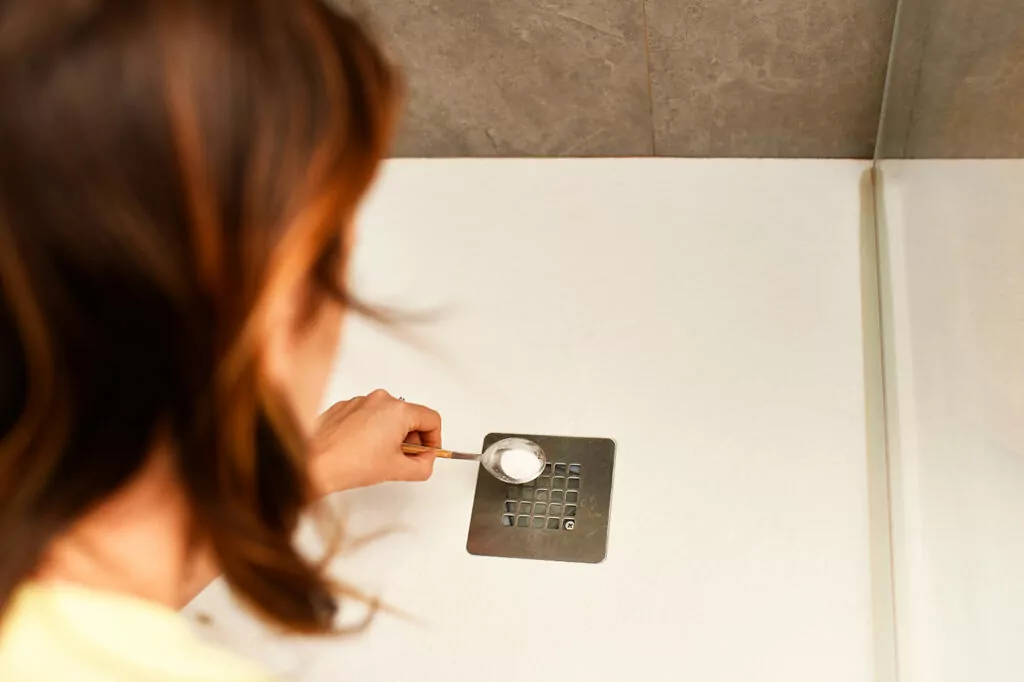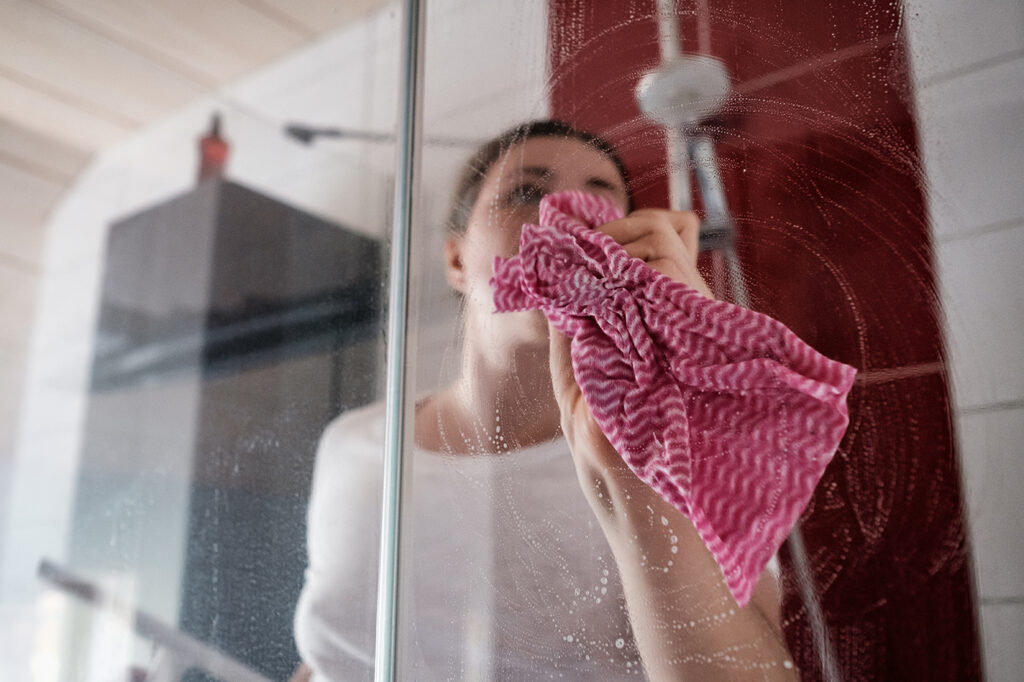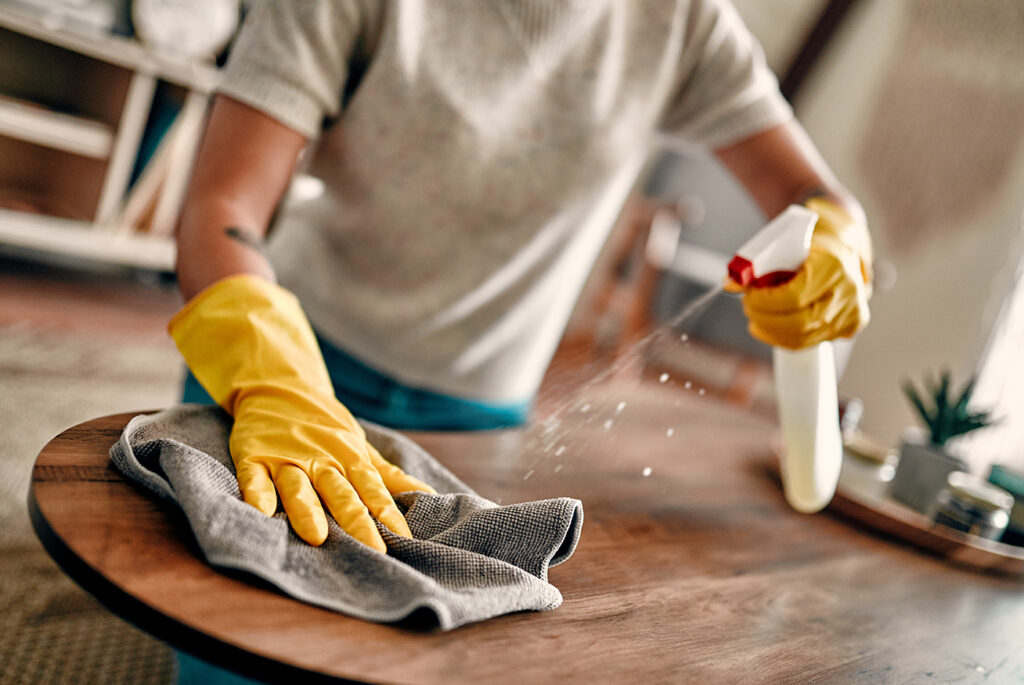Keeping a shower clean is essential for an inviting and clean bathroom. You’ll understand the best way to clean a shower, including different types such as tile, fiberglass, stone, and glass. Whether you’re a seasoned cleaner or a first-timer, this step-by-step guide will help you make your shower sparkle. Regular cleaning not only enhances the aesthetics of your bathroom but also ensures a hygienic environment. Let’s dive in!
Project Overview
Starting a deep cleaning project may seem daunting, but fear not! This project requires minimal time and materials, catering to a beginner skill level. Check out the following breakdown of each type of shower to make sure you have everything you need before starting your deep cleaning journey.
Supplies Needed

Tools and Materials
Cleaning a Tile Shower
- Mild tile cleaner
- Scrub brush
- Grout brush
- Microfiber cloth
- Squeegee
Cleaning a Fiberglass Shower
- Gentle non-abrasive cleaner
- Soft sponge or cloth
- Baking soda
- Water
- White vinegar
Cleaning a Stone Shower
- pH-neutral stone cleaner
- Soft cloth or sponge
- Stone sealer (if applicable)
Cleaning Glass Shower Doors
- White vinegar
- Dish soap
- Lemon oil
- Microfiber cloth
- Rubber squeegee
Cleaning the Shower Drain
- Baking soda
- Vinegar
- Boiling water
- Plunger
- Drain snake
Cleaning the Showerhead
- White vinegar
- Plastic bag
- Wrench
- Toothbrush
Cleaning the Shower Curtain
- Washing machine
- Mild detergent
- Baking soda
- White vinegar
How to Clean a Tile Shower

A spotless tile shower begins with a few essential steps. Let’s delve into how to clean tile shower.
Start with a Preliminary Clean
Before jumping into the deep-cleaning process, take a moment to wipe down surfaces and remove loose debris.
Apply Tile Cleaner
After the preliminary clean, use a mild tile cleaner to tackle the accumulated grime and soap scum. Choose a cleaner that is suitable for your specific tile type in a spray bottle for the best results. The right cleaner not only enhances cleaning efficiency but also preserves the integrity of your tiles.
Focus on Grout Lines
Grout lines are notorious for trapping dirt and stains, making them a focal point of your deep-cleaning mission. Use a grout brush to scrub away stubborn stains and to restore the grout’s original color.
Rinse and Dry
Finally, it’s time to rinse the tiles and grout with warm water. A clean, damp cloth can be used to wipe away any residual cleaning solution. Ensuring a complete rinse is essential for preventing any remaining residue.
Maintain Regularly
Now you know how to clean tile shower,, consider focusing on some simple daily practices that will help you keep your shower consistently clean. Regular maintenance, such as wiping down surfaces after each use and promptly addressing spills or splashes, can significantly extend the time between deep-cleaning sessions.
How to Clean a Fiberglass Shower

When cleaning fiberglass shower, follow these detailed steps, ensuring a thorough and gentle approach.
Prep the Surface
Start by removing loose dirt and debris from the shower’s surfaces. This step is crucial, setting the stage for the following steps to be more effective.
Apply Non-Abrasive Cleaner
Opt for a gentle, non-abrasive cleaner specifically designed for fiberglass. A mild cleaner is your ally in lifting dirt and soap scum without causing harm. This helps prevent any scratching that could compromise the integrity and appearance of your shower.
Scrub with Baking Soda
For those more stubborn stains, harness the power of baking soda. Create a paste by mixing baking soda with water, forming a gentle yet effective solution. Apply the paste to the targeted areas, allowing it to sit for a brief period to penetrate and lift the tough stains.
Rinse and Dry
After the cleaning process is complete, rinse the fiberglass surface with hot water. This step is vital to remove any residual cleaning agents and leave your shower looking immaculate. Once rinsed, use a soft cloth to gently dry the surface, preventing water spots and preserving the polished finish.
Periodic Maintenance
To maintain the shine of your fiberglass shower, consider adding periodic treatments into your cleaning routine. These treatments may include reapplying a protective coating or addressing any other issues promptly. This not only maintains the aesthetic appeal of your shower but also makes cleaning fiberglass shower simpler in the future.
How to Clean a Stone Shower

Stone showers exude a natural beauty, but they require specific care to maintain their elegance. Follow these steps to ensure your stone shower remains pristine:
Gentle Cleaning Solution
Begin your stone shower cleaning regimen with a gentle touch. Utilize a pH-neutral stone cleaner specifically designed to protect the stone surface. This ensures effective cleaning without compromising the natural qualities that make your stone shower a captivating feature in your bathroom.
Soft Cloth or Sponge
The application of the cleaning solution is as crucial as the solution itself. Opt for a soft cloth or sponge to delicately apply the cleaner. This careful method ensures even coverage, preventing any uneven wear on the stone surface and maintaining its uniform appearance.
Address Stains Promptly
Stone surfaces are susceptible to stains, and prompt action is key to maintaining their appearance. Use an appropriate stone-safe cleaner to tackle stains effectively. This targeted approach ensures that stains are addressed without causing damage to the stone, preserving both its aesthetics and structural integrity.
Rinse Thoroughly
Following the application of the cleaning solution and stain treatment, it’s essential to thoroughly rinse the stone surface. This step eliminates any residual cleaner, preventing the buildup of cleaning agents that could compromise the stone’s appearance over time.
Sealing (if applicable)
For added protection and longevity, consider applying a stone sealer (if your specific type of stone benefits from this treatment). A stone sealer forms a protective barrier, guarding the surface against potential damage from water, soap, and other elements. Regular application of a stone sealer contributes to the sustained beauty of your stone shower.
How to Clean Glass Shower Doors

Transparent and sleek, glass shower doors can be a stunning focal point in your bathroom. Keep them crystal clear with these simple steps:
White Vinegar Solution
Begin your glass shower door cleaning process with a white vinegar solution. White vinegar is renowned for its effectiveness in cutting through soap scum and water stains, leaving your glass doors gleaming. Create a mixture of white vinegar and water, ensuring a balanced solution for optimal cleaning power.
Dish Soap Magic
For an extra touch of magic in your cleaning routine, mix dish soap with water. This combination is particularly effective in removing stubborn soap scum and water stains from your glass doors. The soap’s degreasing properties enhance the cleaning power, restoring the transparency of the glass.
Lemon Oil Shine
Take your glass shower doors to the next level by applying lemon oil. Not only does lemon oil add a brilliant shine to the glass surface, but it also leaves behind a fresh and invigorating citrus scent. This step also adds a sensory element to the cleaning process, transforming it into a delightful experience.
Microfiber Cloth
After applying the cleaning solutions, wipe the glass with a microfiber cloth. Microfiber is gentle on glass surfaces and ensures a streak-free finish. This step is essential for achieving the pristine clarity that enhances the overall aesthetic of glass shower doors.
Squeegee After Each Use
Incorporate a proactive approach to maintaining glass shower doors by using a squeegee after each shower. A quick session with a squeegee helps prevent water spots and minimizes the buildup of soap scum. This simple habit goes a long way in maintaining the crystal-clear allure of your glass shower doors between deep-cleaning sessions.
How to Clean the Shower Drain

A clogged shower drain can be a major inconvenience. Keep water flowing smoothly with these simple drain-cleaning steps:
Baking Soda Boost
Initiate your drain-cleaning mission by introducing the power of baking soda. Pour a generous amount down the drain to break down buildup and tackle early signs of clogs. Baking soda acts as a gentle abrasive that helps in dislodging debris in pipes.
Vinegar Power
Follow up the baking soda treatment with the fizzing power of white vinegar. The combination creates a chemical reaction that helps break down and dissolve stubborn debris within the drain. This dynamic duo provides a thorough cleaning, leaving your drain refreshed and free-flowing.
Boiling Water Flush
Elevate your drain-cleaning ritual by carefully pouring boiling water down the drain. The heat aids in flushing away loosened particles, ensuring a clear pathway for water drainage. This step is particularly effective in preventing the accumulation of soap scum, hair, and other materials that contribute to clogs.
Plunger Action
For more resilient clogs, use a plunger. Apply firm yet controlled pressure with the plunger to create a suction force that removes blockages. This hands-on approach is an effective way to address moderate to severe clogs, restoring the optimal functionality of your shower drain.
Drain Snake (if needed)
In the face of persistent clogs, bring out the heavy artillery—a drain snake. This flexible tool is designed to navigate through pipes, dislodging and removing blockages that may be impervious to other methods. Use the drain snake cautiously to avoid any damage to the plumbing.
How to Clean the Showerhead

A clean showerhead ensures a steady and refreshing flow of water. Follow these steps to maintain your showerhead’s performance:
White Vinegar Soak
Take the proactive approach to showerhead cleaning by removing it for a thorough soak. Immerse the showerhead in white vinegar to dissolve mineral deposits that accumulate over time. This soaking process not only cleans the interior components but also contributes to a more efficient and refreshing water flow.
Plastic Bag Method
For an alternative yet equally effective cleaning method, secure a plastic bag filled with vinegar around the showerhead. This technique allows the vinegar to encompass the showerhead, reaching all angles and dissolving any remaining mineral deposits. The bag method provides a hands-free solution for a complete cleaning.
Toothbrush Detailing
Address any lingering buildup with the precision of an old toothbrush. Scrub away stubborn residues and deposits, paying attention to intricate parts that may be harder to reach.
Rinse Thoroughly
After completing the cleaning steps, ensure a thorough rinse to eliminate any lingering vinegar residue. This step is crucial to prevent any potential odor or taste transfer to the water when you next use the shower.
Regular Maintenance
The perfect way for how to deep clean a shower includes incorporating regular cleaning sessions into your maintenance routine to prevent the future buildup of mineral deposits. Consistent care not only preserves optimal water flow but also ensures hygienic glass shower doors and . Make it a habit to clean your showerhead periodically to enjoy the full benefits of your shower.
How to Clean the Shower Curtain

Maintaining a clean shower curtain is crucial for a clean bathroom. Follow these cleaning tips to keep your shower curtain fresh and free from mildew:
Machine Wash
Begin the shower curtain cleaning process by throwing it in the washer. Most fabric shower curtains are machine washable, and this step provides a thorough and efficient cleaning. Refer to the care instructions for your specific curtain to ensure the best results during the machine wash.
Mild Detergent
Opt for a mild detergent when washing your shower curtain to avoid the residue of harsh chemicals. A gentle detergent not only cleans effectively but also maintains the integrity of the curtain material.
Baking Soda Boost
Enhance the cleaning power of your machine wash by adding a boost of baking soda. This versatile ingredient eliminates odors and enhances the overall cleaning effectiveness. Baking soda acts as a natural deodorizer and contributes to a fresh and pleasant atmosphere in your bathroom.
White Vinegar Rinse
Include a white vinegar rinse in your curtain-cleaning routine to prevent the growth of mold and mildew. White vinegar’s natural antimicrobial properties inhibit the development of these unwanted guests, ensuring your curtain remains pristine and free from harmful substances.
Hang to Dry
After the wash and rinse cycles, hang your curtain to dry. Preventing dampness is crucial in stopping the risk of mold growth. Hanging the curtain to dry not only preserves its freshness but also contributes to a healthier and clean bathroom environment.
Shower Cleaning FAQs

Refer to this FAQ section for more insights into common questions about shower cleaning.
Is it better to clean a shower wet or dry?
Cleaning a shower is generally more effective when the surfaces are wet, as this helps to loosen dirt and grime.
How do I deep clean my shower naturally?
Explore natural options like vinegar, baking soda, and lemon for an eco-friendly deep cleaning solution.
How do professionals clean showers?
Professionals often use specialized cleaners and equipment, ensuring a thorough and efficient cleaning process.
Need Cleaning Help?
Completing a deep clean might be a time-consuming task, but the rewards are well worth it. If you find yourself short on time or prefer assistance, consider Taskrabbit’s deep cleaning services. Taskers are the best way to clean a shower and will handle the dirty work, leaving you more time to enjoy your day.
Ready to transform your shower into a haven of cleanliness? Hire a Tasker today and schedule your deep cleaning service. Your sparkling shower awaits!














